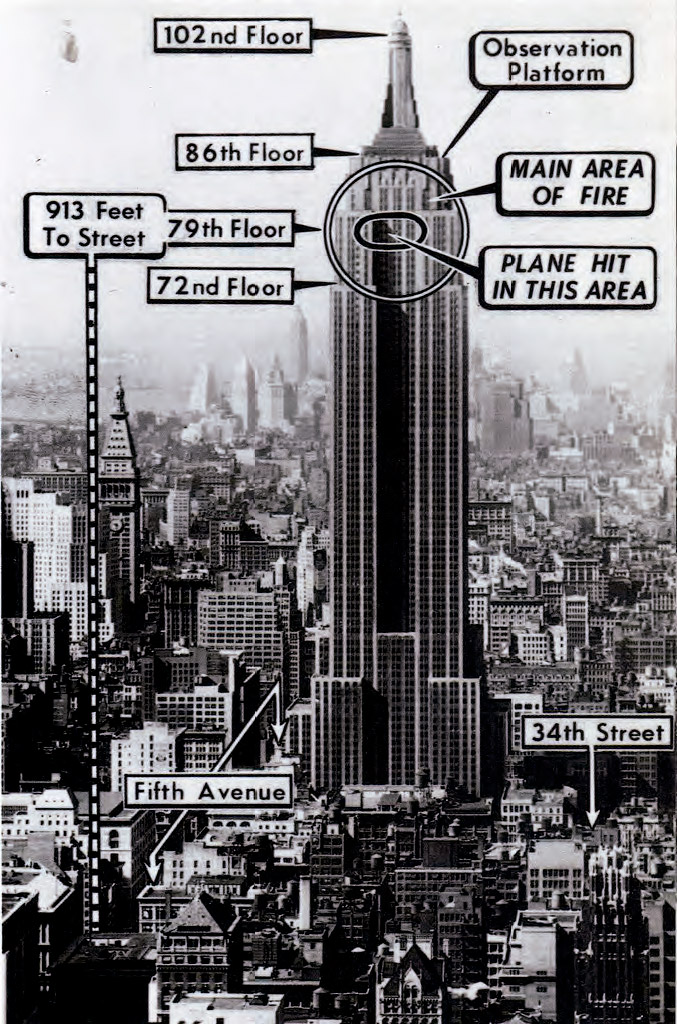In this Readers’ Platform, your author reflects on when a B-25 bomber crashed into the Empire State Building.
by Bud Johnson
July 1945 was a great time to be alive in NYC. Germany had recently surrendered to the Allies, ending World War II in Europe, and Japan would soon be defeated. After five years of war, people felt happy and safe.
The heavy fog covering Manhattan the Saturday morning of July 28, 1945, created a quiet stillness in the air. At 9:49 that morning, that stillness was suddenly and horribly broken when a North American B-25 Mitchell bomber crashed into the 79th floor of the Empire State building (see this month’s Online Extras at elevatorworld.com), killing 11 people in the building and three men in the B-25. The impact created a 20-X-18-ft hole in the building. As the aircraft disintegrated in a ball of fire, debris shot into the building. One of the plane’s engines ripped into the shaft of elevator number six, causing it to freefall 75 floors and crash into the pit. The lone person in the elevator, elevator operator Betty Lou Oliver, miraculously survived.
The B-25 was an outstanding, battle-tested twin-engine medium bomber, but it lacked the sophisticated flying instruments of today’s aircraft. Flying well in adverse weather such as fog depended almost entirely on the vision and skill of the pilot.
Lt. Col. William F. Smith, Jr., was considered a superstar in the U.S. Army Air Corps. He graduated from United States Military Academy West Point, where he was an outstanding student and an All-American lacrosse player. He was only 27 years old but had proven himself as a bomber squadron commander flying combat missions over Germany. He was charismatic, intelligent and fearless. However, he was also overconfident, arrogant and flippant.
Smith had been warned the fog was too thick and that he should stay in Massachusetts for a few hours before taking off. His reason for the flight was to pick up his commanding officer. He could have waited; it wasn’t that important. He had very little experience flying B-25s, as he flew the much-larger Boeing B-17 Flying Fortresses over Germany. Normally, the crew of a B-25 was from four to six men, but Smith didn’t care. The other two men onboard were passengers — a soldier and a sailor. He never should have taken off. But he did.
No one knows for sure what happened in the last seconds before the B-25 crashed into the Empire State Building. It is known that the fog was very thick, Smith was flying low, and 14 people died. People were stunned and saddened when news of the crash was reported on the radio and in newspapers. The one bright spot was the story of how 20-year-old Oliver had survived a 75-floor freefall in her elevator. But hold on. We have been told that elevators are safe — that they can’t fail, that the safety device Elisha Graves Otis invented back in 1854 would prevent this sort of thing. So what happened?
The three major components of the integrated elevator safety system are the safeties, governor and governor rope. We shall concentrate on the governor rope. The governor rope is a wire rope or cable. One end is attached to the elevator. From there, it runs down and around the sheave, or pulley, in the pit, then all the way up the elevator shaft and around the drive sheave on the governor, where the other end is attached to the safety activator.
The function of the governor rope is twofold. It moves with the movements of the elevator and, in doing so, turns the governor sheave, which spins the governor and synchronizes its movement and speed with the elevator. If the car overspeeds, as when falling, the governor reacts by tripping and sets its jaws, which lock onto the rope. Once the jaws are set, the governor rope stops moving, and, in doing so, creates the force that causes the elevator safeties to lock into the main rails and prevent the car from falling. When high-rise elevator number six was constructed in 1931, the safety system was installed on the side of the elevator shaft nearest the outer wall of the building.
When the B-25 engine crashed into the elevator shaft, it severed the governor rope, rendering the safeties useless, before it continued to sever the hoist ropes, causing the elevator to crash into the pit. From then on, when high-rise elevators were installed, the safety system was placed on the side of the shaft farthest from the outside wall. Old timers would say, “Hide the governor rope behind the hoist ropes.”
Epilogue
Oliver was rescued from the crashed elevator with very serious injuries. She was not killed due to factors that provided a “cushion”: The compensating cables hanging from beneath the car piled up in the pit and acted as a coiled spring, and the hatchway itself was of a “high-pressure” design with minimum clearances about the car, causing the trapped air to compress.[1] She spent months in the hospital. Five months after the accident, while still recovering, she returned to the Empire State Building and took a ride on an elevator. She went on to live a beautiful and happy life with her three children, seven grandchildren and husband, Oscar. Oliver passed away on November 24, 1999.
Reference
[1] “Do They Break?” ELEVATOR WORLD,
June 1964.
Get more of Elevator World. Sign up for our free e-newsletter.









